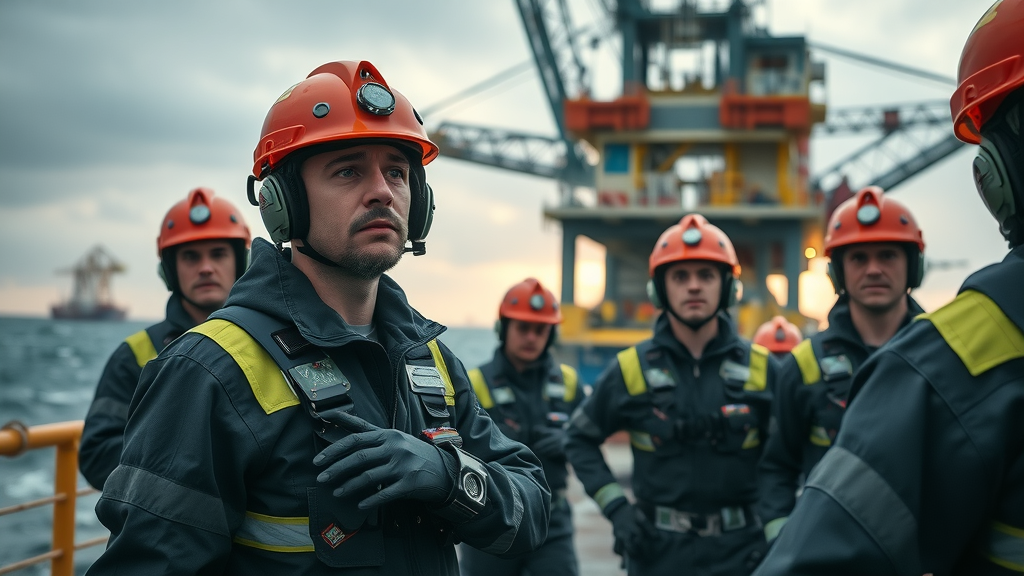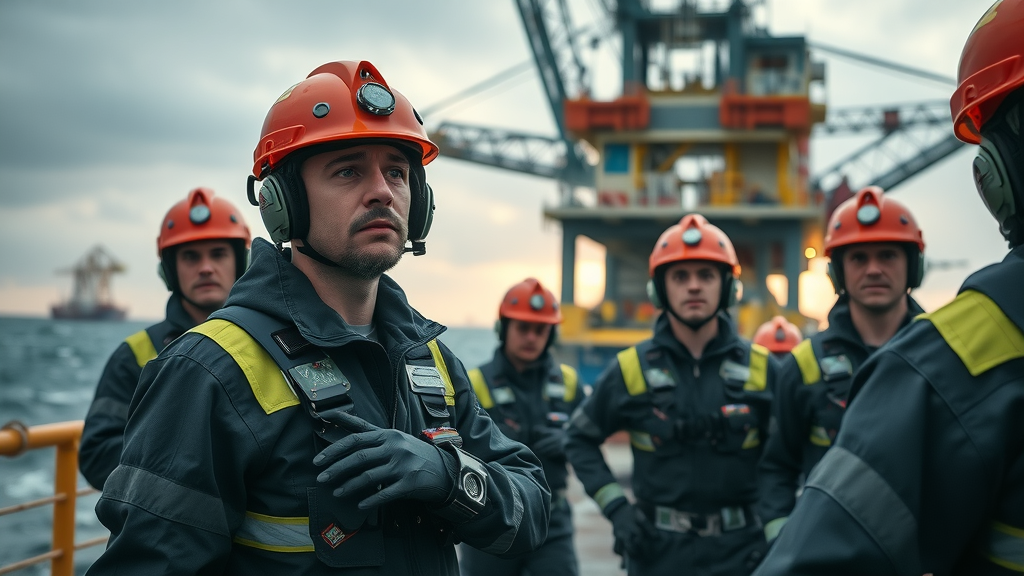
Did you know that 90% of major offshore incidents are tied directly to human error? In the high-stakes world of offshore oil rigs, the right offshore drilling training courses aren’t just a formality—they can be the difference between disaster and a safe return home. Certifications gained through focused training dramatically reduce risks, giving you crucial skills, instilling confidence, and unlocking rewarding opportunities in the energy sector. This guide reveals which certifications truly matter, what you’ll learn, and actionable steps to fast-track your oil and gas career.
Startling Fact: The Impact of Offshore Drilling Training Courses on Oil Rig Safety
“90% of major offshore incidents are due to human error—certified offshore drilling training courses dramatically reduce these risks.”

The link between comprehensive offshore drilling training courses and oil rig safety cannot be overstated. Oil and gas companies prioritize certified training because they know every moment on an oil rig is filled with risks—from equipment malfunctions to emergencies requiring split-second decisions. With the introduction of industry-standard learning courses and hands-on training programs, companies have witnessed a sharp drop in preventable incidents. These courses go beyond basic knowledge and are engineered for the offshore environment, teaching you to recognize hazards, follow strict protocols, and act decisively in emergencies. By investing in your training, you not only protect yourself and your team but also increase your value to leading drilling contractors and secure your future as a trusted rig worker.
Studies have shown that properly certified crews are more likely to prevent accidents and maintain essential control during high-pressure scenarios. Enrolling in robust training courses means you develop expertise in both routine oil rig operations and rare but critical incidents, leading to a safer, more efficient offshore oil workplace. Whether new to the field as a roustabout drilling technician or seeking promotion to a drilling technician role, training is the foundation upon which career advancement and industry reputation are built.
What You’ll Learn in Offshore Drilling Training Courses
-
Key certifications for roustabout drilling technician and drilling technician roles
-
Essential topics covered in offshore training courses
-
How to choose a reputable training center
-
Cost breakdowns and enrollment requirements
-
Steps to launch a career in offshore oil and gas
The leading offshore drilling training courses are designed to provide the core skills and critical certifications demanded by today’s offshore oil and gas industry. You’ll master everything from safety protocols and hands-on rig equipment usage to control training for complex drilling operations. Courses break down key requirements for entry-level roustabout drilling technician jobs and advancement to specialized drilling technician or supervisory roles. Most training programs offer a blend of classroom sessions, simulated emergencies in training labs, and practical exercises on mock oil rig setups—ensuring you’re work-ready for the world’s harshest environments.
Why Offshore Drilling Training Courses Are Critical for Oil and Gas Professionals
In the competitive oil and gas industry, obtaining internationally recognized offshore drilling training courses isn’t an optional extra—it’s a must for anyone serious about working and progressing on offshore oil rigs. Roustabout drilling technicians and drilling technicians handle dangerous equipment, volatile chemicals, and must respond instantly to emergencies. With lives and millions of dollars at stake, finishing a thorough training program gives you the backing of control training, compliance skills, and up-to-date drilling operations knowledge the top drilling contractors demand.
Offshore training is your gateway to roles with higher pay, greater responsibility, and strong job security. From your first day on the rig as a roustabout drilling technician, your safety record and operational expertise set you apart. Most certifications require rigorous exams and supervised training in accredited training centers—a clear sign to employers you’re ready for the challenge. Whether you want to work in the North Sea, Gulf of Mexico, or off the coast of West Africa, respected credentials stay with you and open doors around the world.
Certification Pathways: From Roustabout Drilling Technician to Drilling Operations Expert

The journey in offshore oil and gas often starts as a roustabout drilling technician—handling rig equipment, supporting more experienced technicians, and becoming fluent in safety procedures. Through offshore oil learning courses like BOSIET (Basic Offshore Safety Induction and Emergency Training), HUET (Helicopter Underwater Escape Training), and advanced certificate programs, you’ll move up the ladder. Each step involves more challenging content, from basic rig work safety to control training and supervising complex drilling operations.
As you gain total credit hours and complete modules at accredited training centers, new doors open—to being a drilling technician running core drilling equipment, or to leading teams in the field. Each certificate program is designed to provide practical, hands-on experience. With every completed training program, you strengthen your CV and boost your eligibility for promotions and leadership roles in the world’s top oil and gas companies.
Meeting Industry Standards: Control Training and Compliance
Today’s offshore drilling training courses focus on more than basic skills—they instill a mindset of control and compliance that protects lives and prevents costly incidents. International standards shape the curriculum, and training centers partner closely with major drilling contractors to ensure what you learn matches what’s needed on the rig. Control training covers topics like blowout prevention, well control, equipment shutdowns, and environmental response—essentials for regulatory compliance in oil and gas.
Accredited training is key: Certificates from a reputable learning center prove you’re meeting (or exceeding) the benchmarks set by organizations such as OPITO, IWCF, and IADC. Completing these programs demonstrates dedication to professionalism, safety, and continuous education—the hallmarks of trusted oil rig workers. Employers increasingly require proof of up-to-date training courses and control training, which is why your choice of center and curriculum determines both your long-term career trajectory and daily rig safety.
Comparison of Top Offshore Drilling Training Programs and Certification Requirements
|
Program Name |
Role Focus |
Certification Awarded |
Duration |
Price |
|---|---|---|---|---|
|
BOSIET |
Entry-level, Safety |
Basic Offshore Safety Certificate |
3 Days |
$1,200–$1,800 |
|
HUET |
Helicopter Crew & Rig Workers |
Helicopter Underwater Escape Certificate |
1 Day |
$500–$900 |
|
IWCF Well Control |
Drilling Technician, Supervisors |
Well Control Certificate |
3–5 Days |
$1,500–$2,200 |
|
IADC RigPass |
General Oil and Gas Workers |
RigPass Safety Certificate |
2 Days |
$700–$1,000 |
|
Advanced Drilling Operations |
Senior Drilling Technicians |
Operations Expert Certificate |
5–10 Days |
$2,500–$4,000 |
What Is Covered in Leading Offshore Drilling Training Courses?
A high-quality offshore drilling training course is designed to provide a complete set of skills for thriving on an offshore oil rig. These learning courses combine classroom theory, simulator sessions, and live drilling operations in training labs. Topics range from personal survival techniques, fire prevention, and first aid to advanced modules in blowout prevention and environmental control. You’ll also get technical exposure to rig equipment, offshore communication systems, and the safe handling of hazardous chemicals, laying a strong foundation for a robust oil and gas career.
As a roustabout drilling technician or aspiring drilling technician, you will master recognized health and safety standards, environmental best practices, and cutting-edge drilling technology. Some courses include credit hours spent in simulated rig work, creating a seamless transition to real-world offshore training. The curriculum is frequently updated to reflect industry best practices and regulatory changes, keeping you future-proof in a rapidly evolving energy sector.
Course Breakdown: Safety, Drilling Operations, and Specialized Offshore Training

A typical offshore oil and gas training program is split into several modules over a set number of total credit hours:
-
Personal Safety & Survival: Escape procedures, use of life vests, evacuation drills for platforms and rig vessels.
-
Drilling Operations: Operating drilling equipment, monitoring well conditions, equipment inspection, and troubleshooting.
-
Control Training: Emergency response, shutdown procedures, blowout preventer operation, and regulatory compliance.
-
Specialized Labs: Hands-on application with actual rig equipment, fire-resistant suits, rescue techniques, and teamwork exercises.
-
Continuing Education: Optional modules for experienced technicians (leadership, offshore well planning, advanced maintenance).
Each certificate program is designed to improve both individual and team outcomes—ensuring safe, effective drilling operations and compliance across the petroleum industry. By combining technical knowledge with rigorous hands-on scenarios, these learning courses equip you for both the day-to-day rig work and rare emergencies.
Training Center Selection: How to Find Accredited Learning Courses
Not all training centers are created equal. When evaluating where to take your offshore drilling training courses, prioritize facilities that are internationally accredited and have established partnerships with major oil and gas companies. Look for a training center offering OPITO, IWCF, or IADC certification, which signals quality and global recognition in the industry.
Consider facilities equipped with advanced training labs, experienced instructors with real rig backgrounds, transparent credit hour and certificate program listings, and modern teaching technologies. Check for positive reviews from former students, transparent course pricing, strong job placement support, and opportunities for continuing education. Your future as a drilling technician or roustabout drilling technician depends on choosing a reputable place that’s designed to provide real skills and career security.
Watch: Inside an Offshore Drilling Training Center – A Day in the Life
How to Get Started: Enrolling in Offshore Drilling Training Courses
-
Eligibility and prerequisites: Most programs require a high school diploma or equivalent, strong health, and sometimes previous rig or industrial experience.
-
Training program application process: Submit your application through the training center’s website, provide documentation, complete a physical exam, and await course assignment.
-
Financial considerations and payment plans: Tuition for certificate programs ranges from $500 to $4,000 depending on level and duration—many learning centers offer flexible payment options, company sponsorships, or even scholarships for qualified applicants.
To launch your oil and gas career, begin by researching accredited training centers and identifying which certificate program fits your background and goals. Once accepted, you’ll embark on a journey that combines rigorous classroom learning with hands-on training in simulated offshore environments. Completing your courses is a powerful step towards becoming a certified roustabout drilling technician or advancing to a drilling technician. For many motivated professionals, this is the start of a safe and lucrative rig work journey.
Certifications That Matter: Which Credentials Unlock Offshore Oil Careers?

Choosing the right certifications is key to breaking into the offshore oil and gas industry and establishing yourself as a valuable asset on any rig. Industry demands are clear—without the right credentials, you won’t land the best jobs or progress to sought-after drilling technician roles. The most respected offshore drilling training courses issue globally recognized certifications that stick with you wherever your oil rig journey takes you.
Completing these programs demonstrates to employers and regulators that you meet all requirements for safety, compliance, and technical expertise. Whether entering the industry or upgrading your qualifications for a promotion, the right certification puts you ahead of the competition and secures a place in leading offshore drilling operations worldwide.
Globally Recognized Offshore Training Certifications (BOSIET, HUET, IWCF)
BOSIET (Basic Offshore Safety Induction and Emergency Training): Required by the vast majority of offshore oil rigs and drilling contractors worldwide, BOSIET covers survival techniques, first aid, firefighting, and helicopter safety.
HUET (Helicopter Underwater Escape Training): Highly recommended for any offshore worker traveling by helicopter—this training ensures you know how to react if a helicopter lands in water, a rare but critical risk.
IWCF/IADC Well Control: For roles in drilling operations and well control, these certificates demonstrate mastery in preventing blowouts and handling critical drilling emergencies, a must-have for senior drilling technician jobs.
IADC RigPass: Focuses on safe rig work and operational protocols, serving as a ticket to get on many worksites in the offshore oil and gas sector.
By stacking certifications (starting with BOSIET and progressing to advanced well control certificates), you create a robust portfolio that proves your readiness and adaptability in this high-risk, high-reward field.
Career Progression: From Entry-Level to Offshore Drilling Technician

Starting as a roustabout drilling technician gives you a thorough introduction to rig operations, safety processes, and teamwork. As you complete additional learning courses and accumulate total credit hours, you become eligible for more advanced certificate programs like IWCF Well Control or OPITO OIM Controlling Emergencies. Advancement means moving from general rig support and equipment handling to specialized drilling technician roles—operating sensitive machinery, supervising safety drills, and training future recruits.
Many seasoned technicians continue their education throughout their entire oil and gas career, taking on leadership roles, joining training labs as instructors, or even moving into compliance and safety consultancy. The world’s top drilling contractors invest in their people, and the more you commit to continuing education and upskilling, the safer and more successful your career will become.
Expert Insights: Offshore Drilling Course Alumni Share Their Experience
People Also Ask
Which course is best for offshore?
The best course for offshore work is BOSIET, as it is recognized globally as the fundamental certification required for any position on an offshore oil rig. For those pursuing drilling technician roles or advanced careers, additional certificates like IWCF Well Control and IADC RigPass are also highly recommended. Leading training centers often bundle these certifications to form a comprehensive career-launching package.
How do I get into offshore drilling?
To enter offshore drilling: first, obtain minimum requirements like a high school diploma and good physical health. Next, enroll in accredited offshore drilling training courses at a reputable training center. Start by completing BOSIET for basic eligibility, then specialize through roustabout drilling technician certificate programs and practical training labs. Networking with industry professionals and applying for entry-level oil rig positions further increases your chances.
How much is offshore training?
Offshore training program costs vary with certification and course location. Basic safety certificates like BOSIET range from $1,200 to $1,800. Advanced programs and multi-day learning courses for drilling technicians can cost between $2,000 and $4,000. Many centers offer payment plans, company sponsorships, and financial aid for qualified candidates. Always compare costs by contacting accredited training centers directly.
What certifications do I need to go offshore?
Essential certifications include BOSIET for general offshore access, HUET for helicopter transport, and IWCF/IADC Well Control for technical drilling operations. Oil rig employers may also require supplementary credentials like IADC RigPass and medical fitness certificates. Always verify requirements with your chosen training center or employer before enrolling.
Key Takeaways: Advancing Your Career with Offshore Drilling Training Courses
-
Certifications are essential for career advancement and safety compliance
-
Select accredited training programs to ensure international recognition
-
Continuous learning is vital in the oil rig and drilling operations sector
Frequently Asked Questions about Offshore Drilling Training Courses
-
Are online offshore drilling training courses as effective as in-person?
While online learning courses can provide theoretical background and flexibility, in-person training offers hands-on experience in simulated rig conditions, which is irreplaceable for developing practical skills and confidence needed on an oil rig. -
How long does it take to become a certified drilling technician?
Depending on your background and certificate program, it may take anywhere from a few weeks (for entry-level certification) to several months to gain advanced credentials. Many professionals continue their training as part of ongoing continuing education. -
What are the most respected training centers for oil and gas professionals?
Leading centers include facilities accredited by OPITO, IWCF, and IADC. Research their track record, alumni job placements, and learning labs to find a program that is designed to provide relevant industry skills. -
Is financial aid available for learning courses?
Many training centers offer scholarships, payment plans, and company-sponsored seats for eligible candidates—making a career in offshore oil and gas more accessible than ever.
Conclusion: Invest in Offshore Drilling Training Courses, Safeguard Your Future
The right offshore drilling training courses open doors to safety, professional growth, and adventure—take the next step towards a rewarding oil and gas career today.





